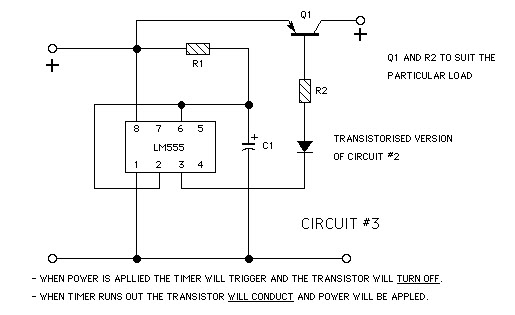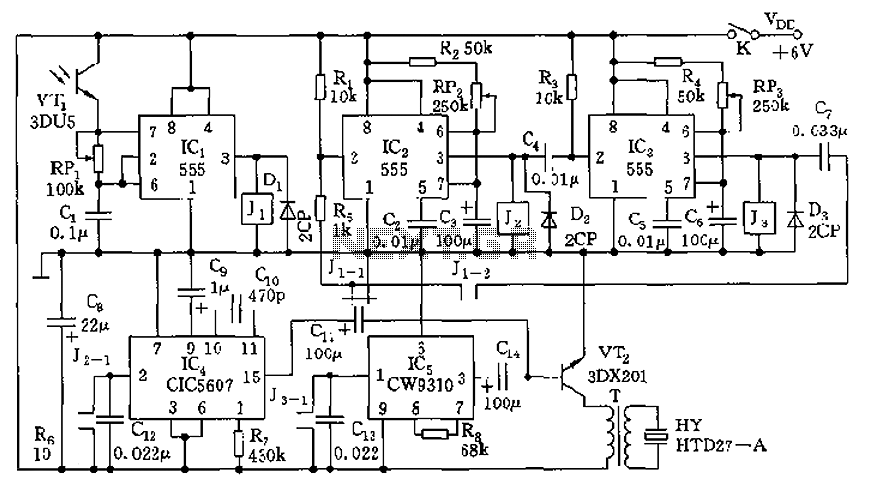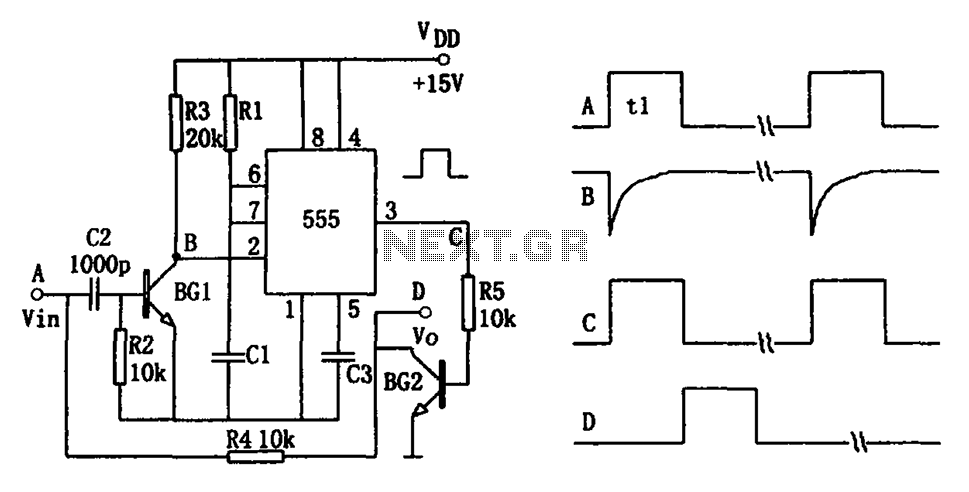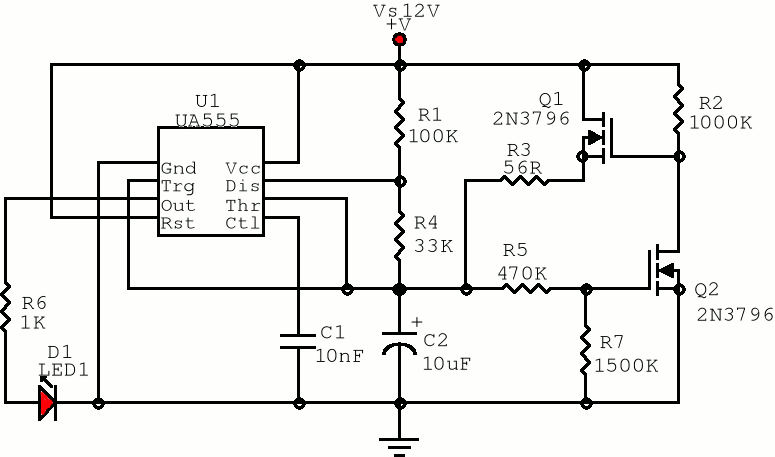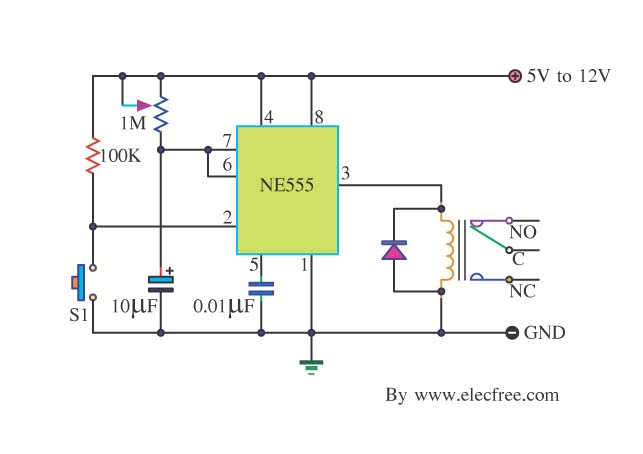
Economy Timer 555 IC
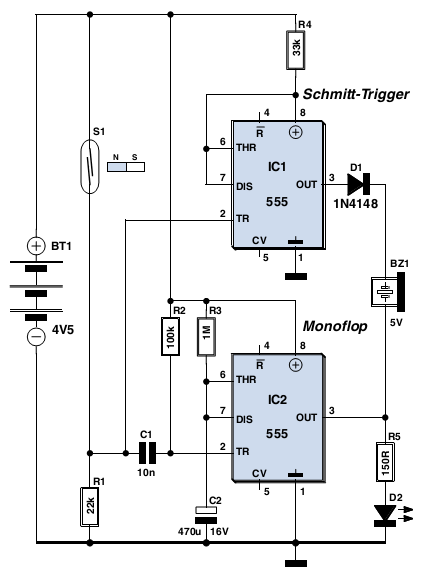
This circuit detects when a window is open (it can also be used with a door), indicates that the window is open by means of a red LED or a blinking LED, and emits a loud acoustic signal from an intermittent electronic buzzer to remind the user to close the window. The active components consist of a pair of type 555 timer ICs. Switch S1 is a reed switch that is attached to the window frame, and when the window is closed, the switch is closed by a magnet attached to the window casement. When the window is opened, S1 opens as well, and the voltage on R1 drops immediately to 0 V. As a result, the trigger input of IC2 is briefly pulled to ground via C1. IC2 is wired as a monostable flip-flop, and it is triggered by this pulse. After C1 charges, the supply voltage is again present at the trigger input of the monostable flip-flop (via R2). This prevents retriggering and allows the monostable to time out normally. The red LED or blinking LED (user option; select the value of the series resistor accordingly) indicates that the timer is running (pin 3 is logic High). The output of the second 555 IC, which is configured as a Schmitt trigger, also goes High when its trigger input is pulled to ground. As a result, the DC buzzer connected between the outputs of the two 555 ICs is not energized because both outputs are High. If the window is closed within the time interval determined by the R3/C2 network, the output of the Schmitt trigger returns to the Low state. If the output of IC2 is still High, diode D1 prevents any current from flowing through the DC buzzer. After the monostable times out, the outputs of both 555 ICs are Low and the buzzer remains silent. If the window is still open when the monostable times out, the Schmitt trigger output remains High, but the monostable output goes Low. As a result, a positive voltage is applied to the buzzer, and it generates an acoustic signal until the window is closed. The buzzer produces an intermittent signal. The time-out interval of the monostable can be calculated reasonably accurately with the formula: t = 1.1 * R3 * C2. With the indicated component values (1 MΩ and 470 µF), the alarm sounds after approximately nine minutes if the window is still open. Instead of the reed switch, a light-dependent resistor (LDR) can be used to detect the light from the refrigerator lamp. If R1 is replaced with a trimpot and adjusted so that the monostable is triggered when the refrigerator lamp goes on (when the refrigerator door is opened), after the monostable times out, the buzzer will remind the user to close the refrigerator door, which is often left open. This circuit can also be used to determine whether the refrigerator lamp actually goes off when the fridge door is closed.
This window and door monitoring circuit utilizes two 555 timer integrated circuits (ICs) to provide visual and audible alerts when a window or door is left open. The circuit is designed to enhance safety and energy efficiency by reminding users to close openings that may lead to energy loss or security vulnerabilities.
The first component, a reed switch (S1), is mounted on the window frame, while a magnet is positioned on the window casement. When the window is closed, the magnet activates the reed switch, effectively completing the circuit. This action allows a voltage to flow through resistor R1, which is connected to a 4.5 V power supply. When the window is opened, the reed switch opens, causing the voltage across R1 to drop to zero. This sudden change triggers the second 555 timer (IC2) in monostable mode, generating a pulse that initiates the alarm sequence.
The capacitor C1 plays a critical role in this process by briefly pulling the trigger input of IC2 to ground. Once C1 charges, the voltage at the trigger input returns to normal levels through resistor R2, ensuring that the monostable timer does not retrigger during its timing cycle. The output from IC2, which is configured as a monostable flip-flop, will remain high for a predetermined duration, indicated by the state of the connected LED.
The second 555 timer is configured as a Schmitt trigger, providing a stable output that controls the buzzer. When the window is closed before the timer times out, the output of the Schmitt trigger returns to a low state, preventing the buzzer from sounding. However, if the window remains open after the timeout, the output of the Schmitt trigger remains high, allowing the buzzer to activate and generate an intermittent sound until the window is closed.
The timing interval for the monostable output can be calculated using the formula t = 1.1 * R3 * C2, where R3 and C2 are the resistor and capacitor values in the timing circuit. With a resistor value of 1 MΩ and a capacitor value of 470 µF, the alarm will sound approximately nine minutes after the window is opened, providing ample time for the user to respond.
This circuit can be adapted for various applications, such as monitoring refrigerator doors using a light-dependent resistor (LDR) in place of the reed switch. This versatility allows the user to customize the circuit for different scenarios, enhancing its practicality and usefulness in everyday situations.This circuit detects when a window is open (it can also be used with a door), indicates that the window is open by means of a red LED or a blinking LED, and emits a loud acoustic signal from an intermittent electronic buzzer to remind you to close the window. The active components consist of a pair of type 555 timer ICs. Switch S1 is a reed switch that is attached to the window frame, and when the window is closed the switch is closed by a magnet attached to the window casement. When the window is closed, the reed switch connects resistor R1 to the 4. 5-V supply voltage. If the window is opened, S1 opens as well and the voltage on R1 drops immediately to 0 V. As a result, the trigger input of IC2 is briefly pulled to ground via C1. IC2 is wired as a monostable flip-flop, and it is triggered by this pulse. After C1 charges, the supply voltage is again present at the trigger input of the monostable flip-flop (via R2). This prevents retriggering and allows the mono-stable to time out normally. The red LED or blinking LED (user option; select the value of the series resistor accordingly) indicates that the timer is running (pin 3 is logic High).
The output of the second 555 IC, which configured as a Schmitt trigger, also goes High when its trigger input is pulled to ground. As a result, the DC buzzer connected between the outputs of the two 555 ICs is not energised because both outputs are High.
If the window is closed within the time inter-val determined by the R3/C2 network, the output of the Schmitt trigger returns to the Low state. If the output of IC2 is still High, diode D1 prevents any current from flowing through the DC buzzer.
After the monostable times out, the out-puts of both 555 ICs are Low and the buzzer remains silent. Things are different if the window is still open when the monostable times out. The Schmitt trigger out-put remains High, but the mono-stable output goes Low. As a result, a positive voltage is applied to the buzzer, and it generates an acoustic signal until the window is closed. As befits an intermittent buzzer, it generates an intermittent signal. The time-out interval of the mono-stable can be calculated reasonably accurately with the formula: t = 1.
1 G— C2 G— R3 With the indicated component values (1 M and 470 µF), the alarm sounds af ter approximately nine minutes if the window is still open. Instead of the reed switch, you can use a light-dependent resistor (LDR) to detect the light from the refrigerator lamp.
If you replace R1 with a trimpot and adjust it so that the monostable is triggered when the refrigerator lamp goes on (when the refrigerator door is opened), after the mono-stable times out the buzzer will remind you to close the refrigerator door (which is often left open). A nice side effect here is that you can use this circuit to definitively answer the age-old question of whether that refrigerator lamp actually goes off when the fridge door is closed ;-).
🔗 External reference
This window and door monitoring circuit utilizes two 555 timer integrated circuits (ICs) to provide visual and audible alerts when a window or door is left open. The circuit is designed to enhance safety and energy efficiency by reminding users to close openings that may lead to energy loss or security vulnerabilities.
The first component, a reed switch (S1), is mounted on the window frame, while a magnet is positioned on the window casement. When the window is closed, the magnet activates the reed switch, effectively completing the circuit. This action allows a voltage to flow through resistor R1, which is connected to a 4.5 V power supply. When the window is opened, the reed switch opens, causing the voltage across R1 to drop to zero. This sudden change triggers the second 555 timer (IC2) in monostable mode, generating a pulse that initiates the alarm sequence.
The capacitor C1 plays a critical role in this process by briefly pulling the trigger input of IC2 to ground. Once C1 charges, the voltage at the trigger input returns to normal levels through resistor R2, ensuring that the monostable timer does not retrigger during its timing cycle. The output from IC2, which is configured as a monostable flip-flop, will remain high for a predetermined duration, indicated by the state of the connected LED.
The second 555 timer is configured as a Schmitt trigger, providing a stable output that controls the buzzer. When the window is closed before the timer times out, the output of the Schmitt trigger returns to a low state, preventing the buzzer from sounding. However, if the window remains open after the timeout, the output of the Schmitt trigger remains high, allowing the buzzer to activate and generate an intermittent sound until the window is closed.
The timing interval for the monostable output can be calculated using the formula t = 1.1 * R3 * C2, where R3 and C2 are the resistor and capacitor values in the timing circuit. With a resistor value of 1 MΩ and a capacitor value of 470 µF, the alarm will sound approximately nine minutes after the window is opened, providing ample time for the user to respond.
This circuit can be adapted for various applications, such as monitoring refrigerator doors using a light-dependent resistor (LDR) in place of the reed switch. This versatility allows the user to customize the circuit for different scenarios, enhancing its practicality and usefulness in everyday situations.This circuit detects when a window is open (it can also be used with a door), indicates that the window is open by means of a red LED or a blinking LED, and emits a loud acoustic signal from an intermittent electronic buzzer to remind you to close the window. The active components consist of a pair of type 555 timer ICs. Switch S1 is a reed switch that is attached to the window frame, and when the window is closed the switch is closed by a magnet attached to the window casement. When the window is closed, the reed switch connects resistor R1 to the 4. 5-V supply voltage. If the window is opened, S1 opens as well and the voltage on R1 drops immediately to 0 V. As a result, the trigger input of IC2 is briefly pulled to ground via C1. IC2 is wired as a monostable flip-flop, and it is triggered by this pulse. After C1 charges, the supply voltage is again present at the trigger input of the monostable flip-flop (via R2). This prevents retriggering and allows the mono-stable to time out normally. The red LED or blinking LED (user option; select the value of the series resistor accordingly) indicates that the timer is running (pin 3 is logic High).
The output of the second 555 IC, which configured as a Schmitt trigger, also goes High when its trigger input is pulled to ground. As a result, the DC buzzer connected between the outputs of the two 555 ICs is not energised because both outputs are High.
If the window is closed within the time inter-val determined by the R3/C2 network, the output of the Schmitt trigger returns to the Low state. If the output of IC2 is still High, diode D1 prevents any current from flowing through the DC buzzer.
After the monostable times out, the out-puts of both 555 ICs are Low and the buzzer remains silent. Things are different if the window is still open when the monostable times out. The Schmitt trigger out-put remains High, but the mono-stable output goes Low. As a result, a positive voltage is applied to the buzzer, and it generates an acoustic signal until the window is closed. As befits an intermittent buzzer, it generates an intermittent signal. The time-out interval of the mono-stable can be calculated reasonably accurately with the formula: t = 1.
1 G— C2 G— R3 With the indicated component values (1 M and 470 µF), the alarm sounds af ter approximately nine minutes if the window is still open. Instead of the reed switch, you can use a light-dependent resistor (LDR) to detect the light from the refrigerator lamp.
If you replace R1 with a trimpot and adjust it so that the monostable is triggered when the refrigerator lamp goes on (when the refrigerator door is opened), after the mono-stable times out the buzzer will remind you to close the refrigerator door (which is often left open). A nice side effect here is that you can use this circuit to definitively answer the age-old question of whether that refrigerator lamp actually goes off when the fridge door is closed ;-).
🔗 External reference
